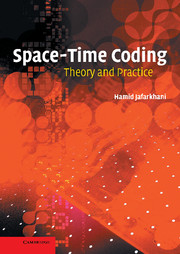Book contents
- Frontmatter
- Contents
- Preface
- Standard notation
- Space-time coding notation
- List of abbreviations
- 1 Introduction
- 2 Capacity of multiple-input multiple-output channels
- 3 Space-time code design criteria
- 4 Orthogonal space-time block codes
- 5 Quasi-orthogonal space-time block codes
- 6 Space-time trellis codes
- 7 Super-orthogonal space-time trellis codes
- 8 Differential space-time modulation
- 9 Spatial multiplexing and receiver design
- 10 Non-orthogonal space-time block codes
- 11 Additional topics in space-time coding
- References
- Index
8 - Differential space-time modulation
Published online by Cambridge University Press: 14 August 2009
- Frontmatter
- Contents
- Preface
- Standard notation
- Space-time coding notation
- List of abbreviations
- 1 Introduction
- 2 Capacity of multiple-input multiple-output channels
- 3 Space-time code design criteria
- 4 Orthogonal space-time block codes
- 5 Quasi-orthogonal space-time block codes
- 6 Space-time trellis codes
- 7 Super-orthogonal space-time trellis codes
- 8 Differential space-time modulation
- 9 Spatial multiplexing and receiver design
- 10 Non-orthogonal space-time block codes
- 11 Additional topics in space-time coding
- References
- Index
Summary
Introduction
The primary focus of the codes that we have discussed so far has been on the case when only the receiver knows the channel. This is the case for most practical systems. The transmitter sends pilot signals and the receiver uses them to estimate the channel [138]. Then, the receiver uses the estimated path gains to coherently decode the data symbols during the same frame. In such a coherent system, the underlying assumption is that the channel does not change during one frame of data. In other words, the frame length is chosen such that the path gain change during one frame is negligible. This is basically the quasi-static fading assumption that we have used so far. There is a bandwidth penalty due to the number of transmitted pilot symbols. Of course, choosing a longer frame reduces this bandwidth penalty; however, on the other hand, the quasi-static assumption is less valid for longer frames. Therefore, there is a trade-off between the frame length and the accuracy of the channel estimation. This is an interesting research topic and the interested reader is referred to [56] and the references therein.
For one transmit antenna, differential detection schemes exist that neither require the knowledge of the channel nor employ pilot symbol transmission. These differential decoding schemes are used, for instance, in the IEEE IS-54 standard [37]. This motivates the generalization of differential detection schemes for the case of multiple transmit antennas.
- Type
- Chapter
- Information
- Space-Time CodingTheory and Practice, pp. 195 - 220Publisher: Cambridge University PressPrint publication year: 2005



